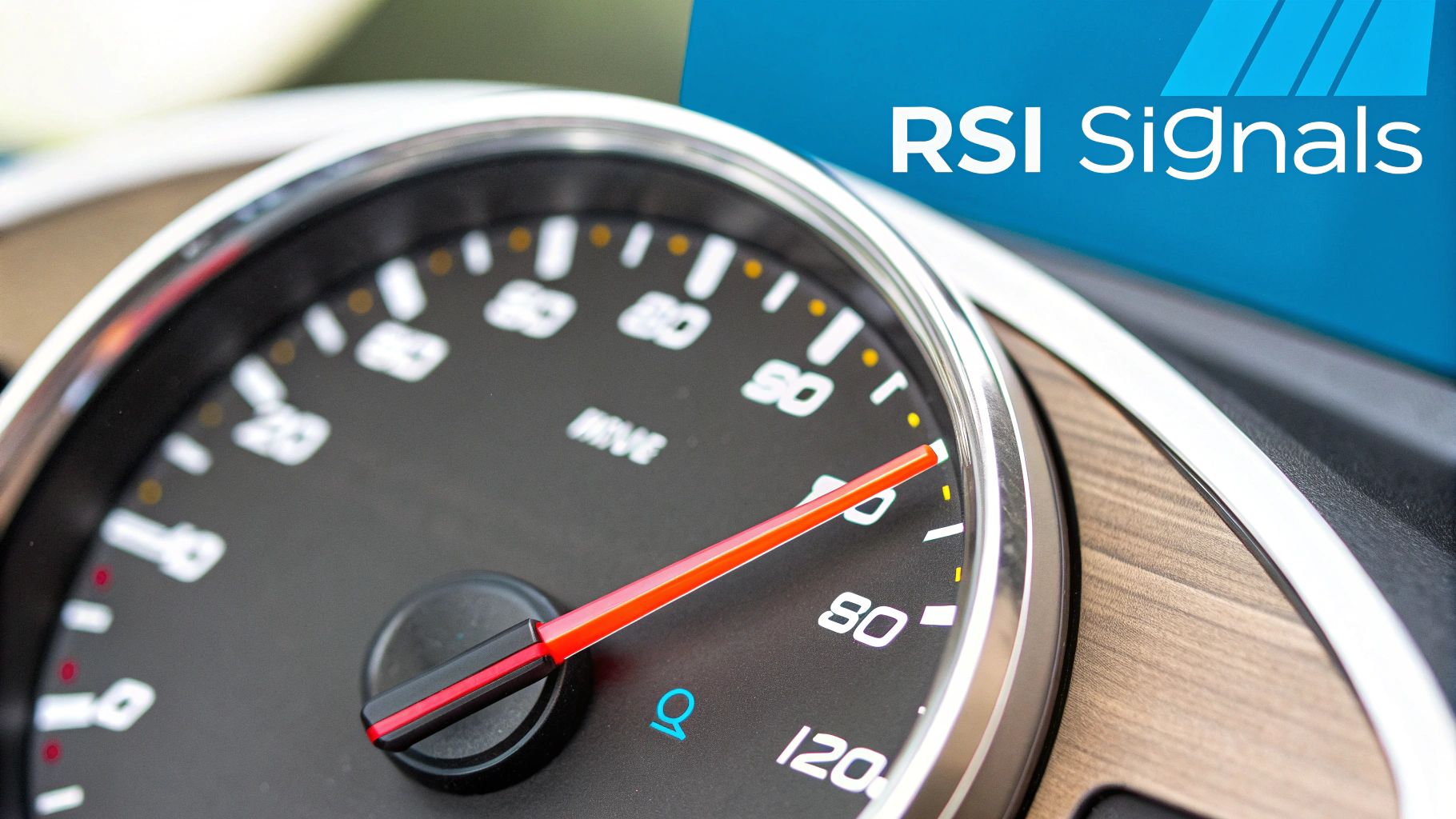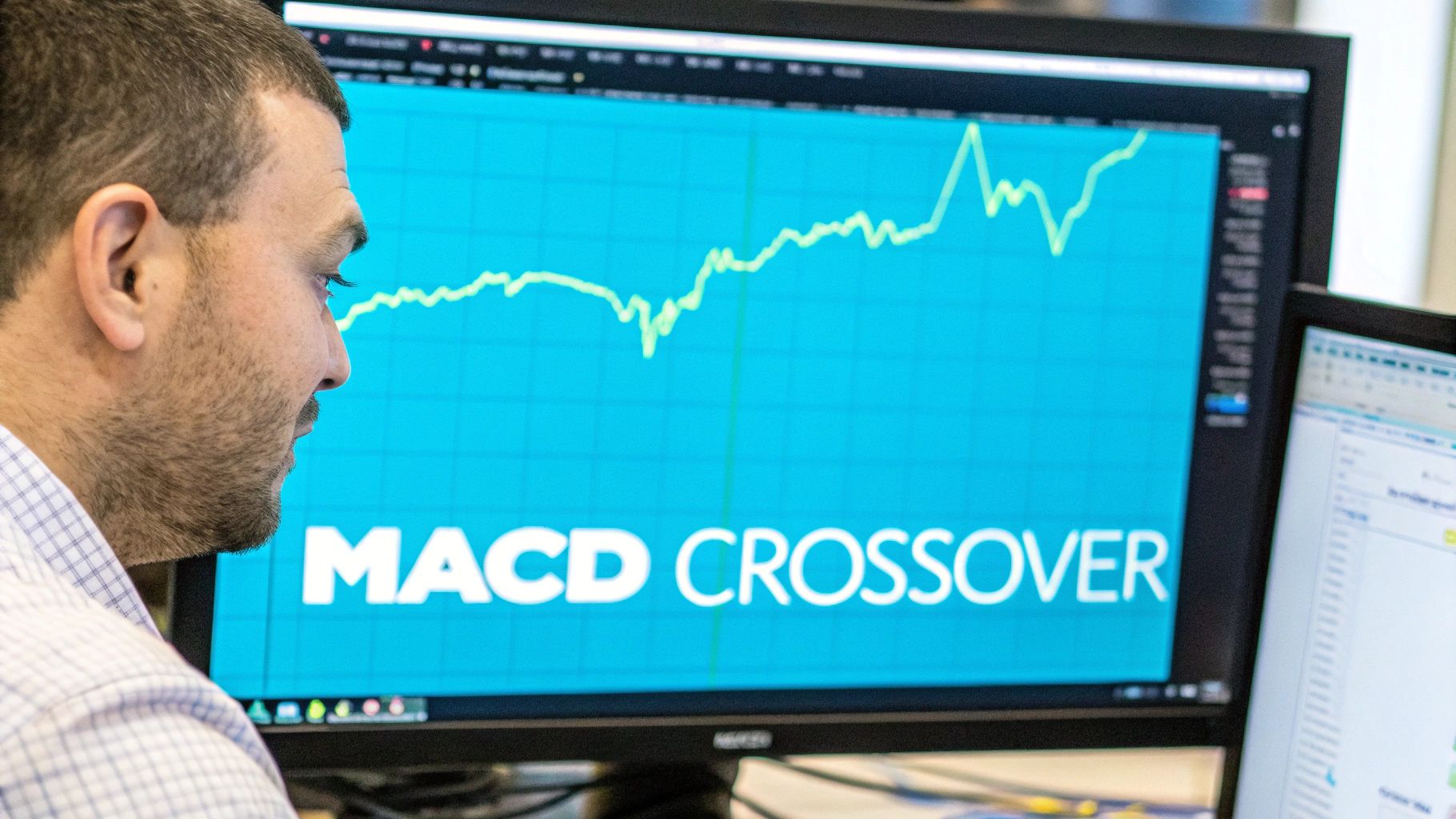




Timing is everything in trading. Entering a position too early can lead to unnecessary losses, while exiting too late can erase hard-earned gains. The difference between a profitable trade and a frustrating one often comes down to one crucial skill: precision. This is where technical indicators become your most valuable tool, acting as a data-driven compass to guide your decisions. Finding the best entry and exit indicators isn't about discovering a single "holy grail" that predicts every market move. Instead, it's about building a robust toolkit that helps you identify high-probability opportunities and manage risk effectively.
This guide cuts through the noise. We will explore a curated list of powerful, time-tested indicators that excel at signaling when to buy and when to sell. You won't find generic advice here. For each indicator, we'll break down exactly how to use it for clear entry and exit signals, supported by practical examples. You will learn how to:
Let's dive into the indicators that can transform your trading approach from reactive to strategic.
The Relative Strength Index, or RSI, is a powerhouse among momentum indicators. Developed by J. Welles Wilder Jr. in 1978, it has become one of the best entry and exit indicators for traders across all markets. The RSI measures the speed and change of price movements on a scale of 0 to 100, helping you quickly identify potentially overbought or oversold conditions. It achieves this by comparing the size of recent gains to recent losses over a specific period, typically 14 days.

The classic application involves monitoring two key levels: 70 and 30. When the RSI moves above 70, the asset is considered overbought, suggesting selling pressure might increase. This could signal a potential exit point for long positions or an entry for a short trade. Conversely, an RSI reading below 30 indicates an oversold condition, where the asset might be undervalued and due for a bounce, signaling a potential entry for a long position.
For example, during major bear market bottoms, Bitcoin’s RSI has frequently dipped below 30, often preceding significant price reversals and presenting prime buying opportunities for long-term investors.
While overbought and oversold levels are useful, they can be misleading in strong trends. To enhance your strategy, consider these advanced techniques:
The Moving Average Convergence Divergence, known as MACD, is a classic trend-following momentum indicator that has earned its place as one of the best entry and exit indicators available. Developed by Gerald Appel in the late 1970s, it visualizes the relationship between two exponential moving averages (EMAs) of an asset's price. The MACD is comprised of the MACD line, the signal line, and a histogram, which all work together to highlight changes in a trend's strength, direction, and momentum.

The primary signals from the MACD are generated by crossovers. When the MACD line crosses above the signal line, it’s considered a bullish signal, suggesting upward momentum is building and presenting a potential entry for a long position. Conversely, when the MACD line crosses below the signal line, it’s a bearish signal, indicating a potential exit for a long position or an entry for a short trade.
A powerful historical example is Tesla (TSLA) stock, where a significant bullish MACD crossover in late 2019 preceded its massive 2020 price rally. Similarly, the MACD is crucial for determining when to exit a trade by identifying weakening momentum before it becomes obvious on the price chart.
To truly harness the power of the MACD, move beyond simple crossovers and incorporate these more nuanced techniques into your analysis:
Bollinger Bands are a fantastic volatility-based indicator created by John Bollinger in the 1980s. They consist of three lines: a middle band, which is a simple moving average (typically 20-period), and two outer bands set at two standard deviations above and below the middle band. The bands expand when volatility increases and contract when it decreases, making them one of the best entry and exit indicators for gauging market conditions dynamically.

The primary use of Bollinger Bands is to identify relative highs and lows. When the price touches the upper band, the asset is considered relatively expensive or overbought. When it touches the lower band, it's considered relatively cheap or oversold. These touches can signal potential reversal points, offering clear entry and exit opportunities.
For instance, a trader might look for an entry when the GBP/JPY currency pair bounces decisively off the lower Bollinger Band during a period of high volatility. Conversely, they might exit a long position when the price hits the upper band. The bands act as dynamic support and resistance levels that adapt to the market's current state.
To get the most out of this versatile tool, move beyond simple overbought/oversold signals and incorporate these advanced tactics:
The Stochastic Oscillator is a classic momentum indicator developed by George Lane in the 1950s. It operates on the principle that as prices rise, closing prices tend to be closer to the high of the recent price range, and as prices fall, they tend to be closer to the low. This indicator compares a security’s closing price to its price range over a specific period, making it one of the best entry and exit indicators for identifying momentum shifts. It consists of two lines, %K and %D, that oscillate between 0 and 100.
The primary use of the Stochastic Oscillator involves tracking overbought and oversold levels. A reading above 80 suggests the asset is overbought, potentially signaling a good exit point for a long position or an entry for a short trade. Conversely, a reading below 20 indicates an oversold condition, suggesting the asset may be due for a bullish reversal, offering a potential entry for a long position.
For instance, forex traders often use the Stochastic Oscillator to time entries and exits when a pair like EUR/USD is trading within a defined range. When the indicator hits the overbought zone near the top of the range, it signals a potential sell opportunity.
Relying solely on overbought and oversold levels can be risky, especially in strong trending markets. To refine your approach, incorporate these advanced techniques:
The Volume Weighted Average Price, or VWAP, is a benchmark used heavily by day traders and institutional firms. It calculates the average price of an asset over the day, weighted by trading volume. Unlike a simple moving average, VWAP gives more weight to price levels where more trading activity occurred, making it a powerful tool for gauging the true "fair value" on an intraday basis. Because it resets at the start of each trading day, it is one of the best entry and exit indicators for short-term strategies.
The primary function of VWAP is to act as a dynamic level of support or resistance. When the price is trading above the VWAP line, it suggests that buyers are in control, creating a bullish bias for the session. This is often seen as a good area to initiate or hold long positions. Conversely, when the price falls below VWAP, it indicates sellers are dominating, establishing a bearish bias and signaling potential exit points for longs or entries for short trades.
For example, many day traders watch the SPY exchange-traded fund. A common strategy involves waiting for the price to pull back to the VWAP line during an uptrend. If the price bounces off the VWAP and continues higher, it serves as a high-probability entry signal.
While using VWAP as a simple support or resistance level is effective, you can refine its application with these advanced tips:
Fibonacci Retracement is a staple in the toolkit of technical analysts, making it one of the best entry and exit indicators for identifying hidden support and resistance. Based on the mathematical sequence discovered by Leonardo Fibonacci, this tool uses horizontal lines to pinpoint potential reversal zones. The key retracement levels are 23.6%, 38.2%, 50%, 61.8%, and 78.6%. When applied to a price chart, these levels represent areas where a price pullback might pause or reverse, offering strategic entry and exit points.
To use the tool, you identify a significant price move, known as a swing high and a swing low, and draw the retracement levels between these two points. During an uptrend, traders watch for the price to pull back to one of these Fibonacci levels to find support before entering a long position. In a downtrend, these levels act as resistance, presenting potential entry points for short trades. The exit is often set just below the next support level or above the next resistance.
For example, it is common to see Bitcoin retrace to its 61.8% level during a strong uptrend before resuming its upward trajectory, offering a high-probability buy-the-dip opportunity. Similarly, a stock like Apple might find solid support at the 38.2% retracement during a minor market correction.
Drawing lines is easy, but profiting from them requires skill. To sharpen your Fibonacci strategy, apply these advanced tips:
Support and resistance levels are the foundation of technical analysis and rank among the best entry and exit indicators due to their clarity and reliability. These horizontal price zones represent areas where supply and demand have historically met with force. Support is a price level where buying pressure consistently overcomes selling pressure, causing the price to bounce. Resistance is the opposite, a level where selling pressure overwhelms buying pressure, halting upward movement.
This infographic visualizes the core components that create and validate these crucial price zones.
The map illustrates how traders identify these levels by looking at historical swing points, psychological round numbers, and confirming their strength with volume analysis.
The strategy is straightforward: buy near support and sell near resistance. When a price approaches a well-established support level, it signals a potential low-risk entry point for a long position. Conversely, as the price nears a strong resistance level, it presents a potential exit point for a long trade or an entry for a short position.
For instance, the S&P 500 repeatedly found resistance near the 4,000 level, offering clear opportunities for traders to take profits or initiate short positions. A break above such a level often signals the start of a new, powerful trend.
Identifying these levels is a skill that improves with practice. To enhance your trading, focus on these techniques:
The Ichimoku Cloud, or Ichimoku Kinko Hyo, is a complete, all-in-one technical analysis tool that offers a panoramic view of the market. Developed by Goichi Hosoda in the late 1960s, it provides data on support and resistance, trend direction, and momentum simultaneously. This makes it one of the best entry and exit indicators for traders who prefer a comprehensive, visual approach to analyzing price action. The indicator consists of five main lines and a "cloud" (Kumo), which together define market structure and potential trade opportunities.
The core of the Ichimoku system is the cloud itself, formed by Senkou Span A and Senkou Span B. When the price is trading above the cloud, the trend is considered bullish, presenting potential long entry signals. When the price is below the cloud, the trend is bearish, signaling potential short entries or exits for long positions. The cloud also acts as dynamic support and resistance; a thicker cloud suggests stronger levels.
For example, forex traders often use the Ichimoku Cloud on the USD/JPY pair to follow long-term trends. A break above a red (bearish) cloud into a green (bullish) cloud is often seen as a powerful buy signal that can precede a sustained upward move.
To truly harness the power of this multifaceted indicator, you need to look beyond just the cloud itself. These techniques will sharpen your trading edge:
Navigating the world of technical analysis can feel like learning a new language. Throughout this guide, we've deciphered the grammar and syntax of eight of the most reliable tools available to traders. From the momentum-gauging power of the RSI and MACD to the dynamic support and resistance offered by Bollinger Bands and VWAP, each indicator provides a unique lens through which to view market behavior.
We’ve seen how the Stochastic Oscillator excels at identifying overbought and oversold conditions in ranging markets, while Fibonacci Retracement helps predict where a price pullback might end. Classic Support and Resistance levels provide the foundational framework of market structure, and the comprehensive Ichimoku Cloud offers a complete, all-in-one system for trend, momentum, and future potential. Mastering these tools individually is the first step; the real art lies in weaving them together into a cohesive strategy.
The most critical takeaway is this: no single indicator is a magic bullet. Relying on just one tool, whether it's the RSI or MACD, is like trying to navigate a ship with only a compass but no map. You have a sense of direction but no context for the journey. The strongest trading decisions are born from confluence, the point where multiple, independent indicators align to tell the same story.
For example, a compelling long entry signal isn't just the RSI crossing above 30. A truly high-probability setup might look like this:
When several of these best entry and exit indicators point to the same conclusion, your confidence in the trade grows exponentially. This multi-layered approach filters out market noise and reduces the likelihood of acting on false signals, which is the cornerstone of consistent profitability.
The journey from knowledge to consistent application requires a structured plan. Instead of trying to master everything at once, focus on a methodical approach.
Mastering the best entry and exit indicators is not about memorizing formulas; it's about understanding market psychology and developing a system that gives you a repeatable edge. This process transforms you from a reactive market participant into a proactive strategist, ready to seize opportunities with clarity and conviction.
Ready to supercharge your analysis and eliminate the guesswork? The EzAlgo toolkit integrates many of these powerful concepts into a single, streamlined system, providing clear buy/sell signals, automatic support and resistance levels, and real-time divergence detection directly on your TradingView charts. Stop staring at confusing indicators and start trading with confidence by visiting EzAlgo to see how our algorithms can elevate your strategy today.